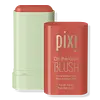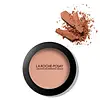What's inside
What's inside
 Key Ingredients
Key Ingredients

 Benefits
Benefits

No benefits
 Concerns
Concerns

 Ingredients Side-by-side
Ingredients Side-by-side

Diisostearyl Malate
EmollientCaprylic/Capric Triglyceride
MaskingPolyglyceryl-2 Triisostearate
EmulsifyingCeresin
Emulsion StabilisingTriethylhexanoin
MaskingOzokerite
Emulsion StabilisingPentaerythrityl Tetraisostearate
EmollientHdi/Trimethylol Hexyllactone Crosspolymer
Bis-Diglyceryl Polyacyladipate-2
EmollientRicinus Communis Seed Oil
MaskingHydrogenated Castor Oil
EmollientPhytosteryl/Isostearyl/Cetyl/Stearyl/Behenyl Dimer Dilinoleate
Skin ConditioningHippophae Rhamnoides Oil
EmollientTocopheryl Acetate
AntioxidantAscorbic Acid
AntioxidantErgosterol
Skin ConditioningVitis Vinifera Fruit Extract
Skin ConditioningVaccinium Angustifolium Fruit Extract
Skin ProtectingRubus Idaeus Fruit Extract
AstringentPyrus Malus Fruit Extract
Skin ConditioningPanax Ginseng Root Extract
EmollientHamamelis Virginiana Extract
AntiseborrhoeicFragaria Chiloensis Fruit Extract
Skin ConditioningCitrus Limon Fruit Extract
MaskingCamellia Sinensis Leaf Extract
AntimicrobialAloe Barbadensis Leaf Extract
EmollientHydrogenated Castor Oil Isostearate
Skin ConditioningSilica
AbrasiveWater
Skin Conditioning1,2-Hexanediol
Skin ConditioningPhenoxyethanol
PreservativeCI 77891
Cosmetic ColorantCI 15850
Cosmetic ColorantCI 15985
Cosmetic ColorantDiisostearyl Malate, Caprylic/Capric Triglyceride, Polyglyceryl-2 Triisostearate, Ceresin, Triethylhexanoin, Ozokerite, Pentaerythrityl Tetraisostearate, Hdi/Trimethylol Hexyllactone Crosspolymer, Bis-Diglyceryl Polyacyladipate-2, Ricinus Communis Seed Oil, Hydrogenated Castor Oil, Phytosteryl/Isostearyl/Cetyl/Stearyl/Behenyl Dimer Dilinoleate, Hippophae Rhamnoides Oil, Tocopheryl Acetate, Ascorbic Acid, Ergosterol, Vitis Vinifera Fruit Extract, Vaccinium Angustifolium Fruit Extract, Rubus Idaeus Fruit Extract, Pyrus Malus Fruit Extract, Panax Ginseng Root Extract, Hamamelis Virginiana Extract, Fragaria Chiloensis Fruit Extract, Citrus Limon Fruit Extract, Camellia Sinensis Leaf Extract, Aloe Barbadensis Leaf Extract, Hydrogenated Castor Oil Isostearate, Silica, Water, 1,2-Hexanediol, Phenoxyethanol, CI 77891, CI 15850, CI 15985
 Reviews
Reviews

Ingredients Explained
These ingredients are found in both products.
Ingredients higher up in an ingredient list are typically present in a larger amount.
Ci 15850 is the pigment color red. It is an azo dye and created synthetically.
Azo dyes need to be thoroughly purified before use. This allows them to be more stable and longer-lasting.
This ingredient is common in foundations, lipsticks, and blushes. This color is described as brown/orangey red.
It has many secondary names such as Red 6 and Red 7. According to a manufacturer, Red 6 usually contains aluminum.
Learn more about CI 15850Ci 77891 is a white pigment from Titanium dioxide. It is naturally found in minerals such as rutile and ilmenite.
It's main function is to add a white color to cosmetics. It can also be mixed with other colors to create different shades.
Ci 77891 is commonly found in sunscreens due to its ability to block UV rays.
Learn more about CI 77891Silica, also known as silicon dioxide, is a naturally occurring mineral. It is used as a fine, spherical, and porous powder in cosmetics.
Though it has exfoliant properties, the function of silica varies depending on the product.
The unique structure of silica enhances the spreadability and adds smoothness, making it a great texture enhancer.
It is also used as an active carrier, emulsifier, and mattifier due to its ability to absorb excess oil.
In some products, tiny microneedles called spicules are made from silica or hydrolyzed sponge. When you rub them in, they lightly polish away dead skin layers and enhance the penetration of active ingredients.
Learn more about Silica